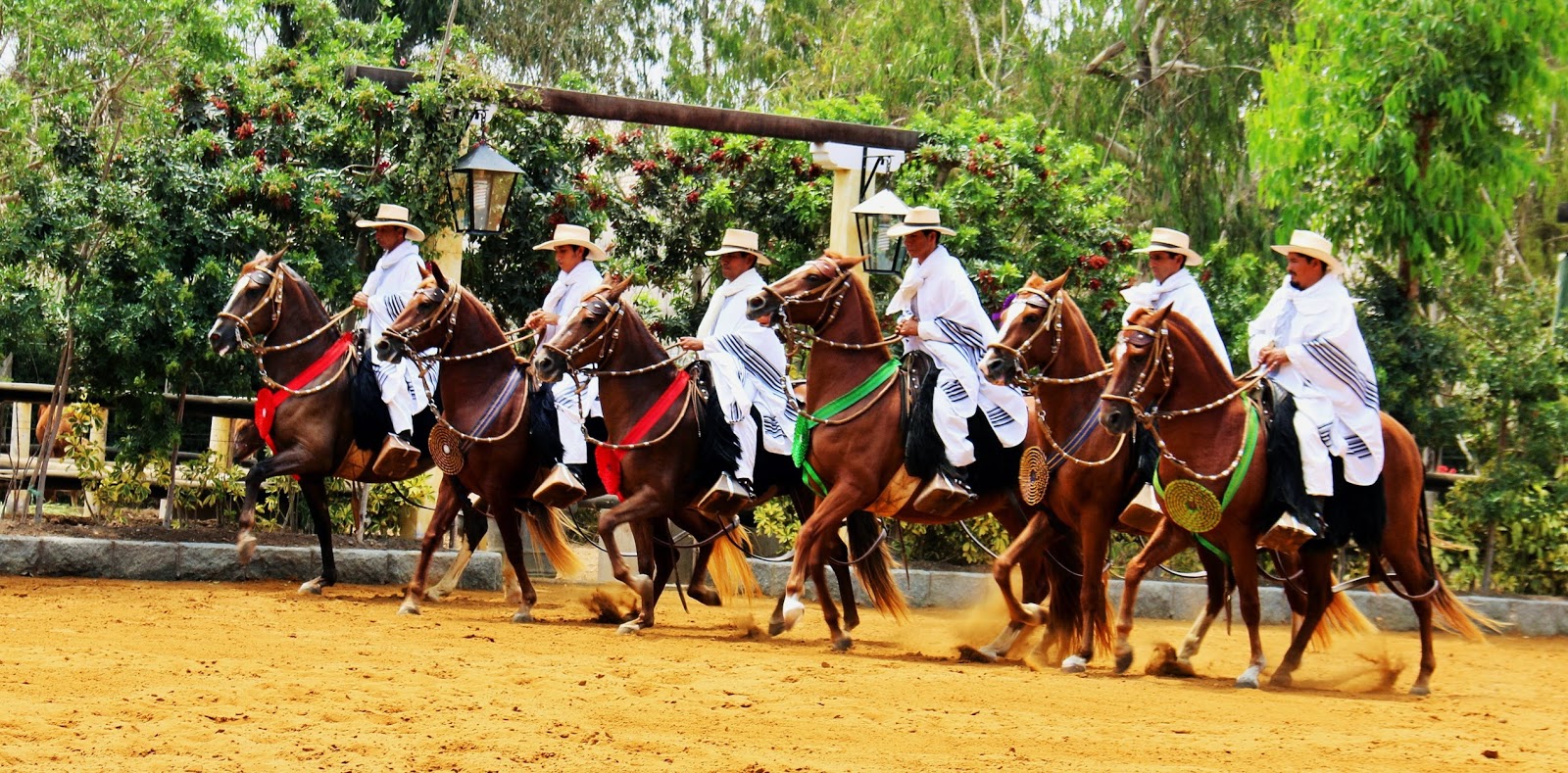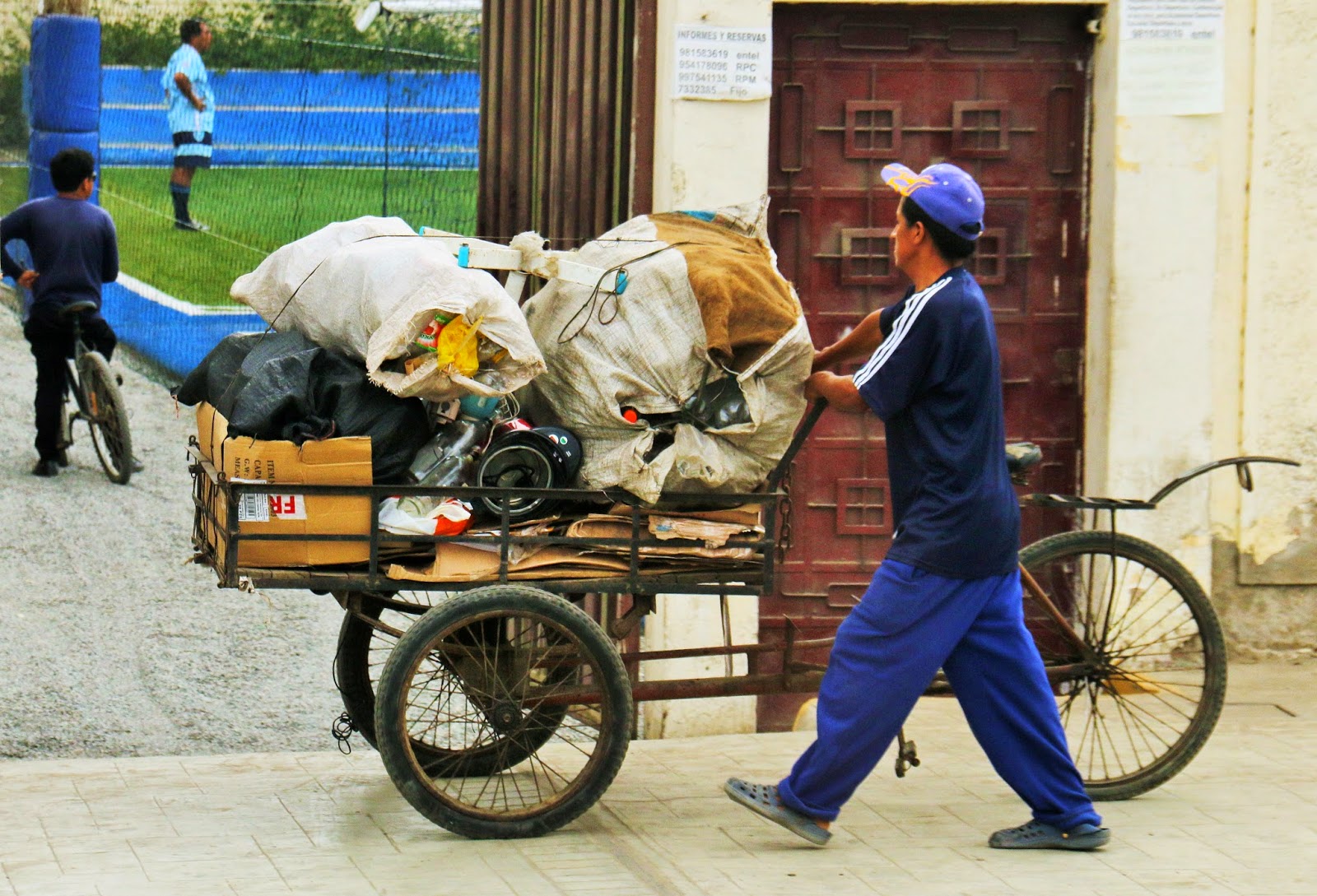We were still in Lima March 20
(Friday), or at least its port. We knew
we were in port as we didn’t get much sleep.
The port apparently never sleeps at night. There were cranes with back up lights beeping
the entire night. There were trucks
being loaded with grain from ships.
There was construction and the scraping of front-end loaders as they
gathered rocks and dirt and dumped it.
Good grief. Our side of the ship
was not the place to be. I was hoping
they were only working til midnight.
Nope. All night long. Until we left on our excursion when
everything seemed to shut down.
Today we were back on a bus to
visit the Museum of Anthropology and Archeology, visit the Pachacamac Ruins and
be treated to a show by Peruvian Paso prancing horses.
.JPG) |
| There are always carts of some sort to photograph. |
Our first stop was the
museum. While I enjoy museums, the time
spent at this one was a little too much and I ended up wandering around on my
own. I can only pay attention for so
long. But there were a lot of
interesting things there so I found ways to entertain myself.
.JPG) |
| The museum is beautiful with displays in outdoor halls. |
.JPG) |
| The place has archways throughout and an old floor of black and white tiles. |
.JPG) |
| Some of the pottery was nice but it's difficult to take photos when it's enclosed in cases.. |
.JPG) |
| This lady was carving some type of gourd and her things were quite nice. |
There is always pottery, and so I
take pottery photos. The best part of
this museum was that they had replicas of some items out so you could handle them,
which I did. The ones I took photos of
seemed to be teapots.
.JPG) |
| This one had nice color. |
.JPG) |
| And this one had a cool cat of some type. |
.JPG) |
| It was fun to dry on a head dress. |
The museum had some space
dedicated to temporary body painting that was used during events such as
ceremonies or celebrations. It was quite
fascinating the colors they mixed and used.
The painting was especially used on their faces and could be single- or
multi-colored with a variety of patterns.
Burial rituals used a red dye applied over the body.
.JPG) |
| Pretty. |
.JPG) |
| But scary. |
Another part of the museum was dedicated
to intentional skull modification, used by the Paracas people and possibly
related to different social standings.
They used two techniques on youngsters as their bones were still soft
and developing. The first, called the
crib, used ropes on a child’s head. The
second used a headband (llautu) where they tied ribbons or ropes around the
child’s head. Both methods may have also
used accessories of tablets or cotton pads and nuts.
The cotton nuts were typical
modeling tools of the time and some have been found still tied to children’s
skulls using sashes. Different head shapes were possible by rearranging the
ropes and altering the form or size of the modeling accessories. They kind of sound alike to me, but were
described in the museum as two variations of the same thing.
.JPG) |
| Compression around the head with sashes and llautos like the one above resulted in a cylindrical shape. Placing the rope in different positions provided variety among individuals. |
.JPG) |
| This skull matches the one from the above photo. |
With tablets and pads applied on
the forehead and the back of the head a conical or truncated cone shape was
achieved. Most of the cases found were
this type, which was also very common among the Paracas Cavernas people.
.JPG) |
| And little birds occupied our time, too. |
From there we reboarded our bus
and headed to the ruins.
.JPG) |
| There are always things to photograph, like racing taxis. |
.JPG) |
| Or cops with guns. There are a lot of those. |
These were
intriguing as they are located in an area surrounded by residential areas. While it was quite hot, we got in and out of
the bus to photograph. It was
particularly interesting as there were people working to continue to uncover
the ruins.
.JPG) |
| You can see the houses are not very far away, and can also see some old earthquake damage. |
The Pachacamac ruins are centuries-old
remnants of the Incan Empire, built in about 700 A.D. It has plazas, palaces, temples,
monuments and pyramids, some of which is quite apparent, and is believed to
have been a main pilgrimage center.
.JPG) |
They're working in many locations throughout the ruins. |
.JPG) |
| The city surrounds the ruins in all directions. |
.JPG) |
| And you can see how close everywhere you look. There are more workers here, as well. |
.JPG) |
| There's still a lot to do. |
These people also believed in
sacrifices, llamas and youngsters, usually virgins, of upper class
families. Someone asked if the sacrifices
were drugged first and our guide told us they were. Glad I’m of a lowly nature and won’t be
sacrificed anytime soon.
.JPG) |
The Mamacona was built by the Inca for women dedicated to
the cult of the sun god and was a place for them to produce fine goods. There are three sectors … structures with
galleries and staircases, areas between them and large patios. Typical Inca architecture shows in the
trapezoidal niches, decorated ashlars and windows. I overheard a couple of folks saying this was
a reproduction, but it appeared to be ruins that had been discovered and
rebuilt adding some support structure.
|
.JPG) |
| There are guards everywhere to prevent pilfering and vandalism. At the hill in the distance, there is another guard. |
We left the ruins behind and
headed to another location to see Peruvian prancing horses. We were taken to local hacienda with
beautiful gardens and grass that was like velvet. We were seated next to a soft dirt arena for
our show, offered drinks and potatoes cooked in one of the thousands of ways
that they can be cooked in this country, and sat back to watch.
.JPG) |
| It wasn't my favorite way to eat potatoes but these were with a dipping sauce and not bad. |
.JPG) |
| And we had a little show of dancing. The dancers were lovely and graceful, performing on the dirt like it was the floor of the greatest theater in the world. |
Our host gave us a brief history
of the Paso, or gaited horses. They have
been bred to be gaited and have a natural beauty through long manes and tails. For these horses that also means a short neck
that is held high and a gait that is not like other horses. Their gait makes for an exceptionally smooth
ride, and I can only imagine it to be similar to that of a Tennessee Walker
which I’ve ridden. It’s smooth and a
luxurious ride.
.JPG) |
| Our host rode in on one of these magnificent animals. |
.JPG) |
| Others dressed in Peruvian dress came into the ring. |
.JPG) |
| This is only three of the six performers. |
.JPG) |
| Beautiful horses. |
.JPG) |
| Coming around toward us. |
.JPG) |
| And going away from us. |
In addition to watching these
graceful horses, we were treated to a folkloric show with dancers and a
wonderful lunch. It was a great oasis of
time during a day of bus riding that can be tedious at best.
.JPG) |
| They showed off this little filly with the beautiful face. |
.JPG) |
| More dancing. |
.JPG) |
| And some of the setting of this beautiful place. |
.JPG) |
| But a little nuzzle on the way out was a nice way to say goodbye. |
All too soon we had to be on our
way back to the port, via another piece of the Pan American Highway. Our drive was not without its own adventure and
was about an hour-and-a-half longer than it should have been. There’d been a bad accident that had slowed
everything down and the roads were parking lots. It also made for some very creative driving.
.JPG) |
| There was the biggest beer ad I'd ever seen, standing free-style, not a billboard. |
.JPG) |
| Glad I wasn't driving. |
.JPG) |
| They put flowers on the outside of the hearse. You see interesting things from a bus window. |
The good news is that while we
were the last bus back to the port, if you’re on a Princess-arranged excursion
they won’t leave you behind, or at least will make arrangements for you if they
have to do that. However, we figure the
captain was tapping his foot and watching the clock impatiently awaiting our
arrival.
.JPG) |
| I'm a sucker for photographing the carts. |
.JPG) |
| This one was very unique. |
.JPG) |
| Goodbye, Peru. |
By the time we returned to our
ship, all was quiet. The trucks were
gone, the ships were unloaded, the vans had been loaded onto trucks and were
gone, the cranes were not moving and the construction project had shut down. It was time for us to vacate our berth.
.JPG)
.JPG)
.JPG)
.JPG)
.JPG)
.JPG)
.JPG)
.JPG)
.JPG)
.JPG)
.JPG)
.JPG)
.JPG)
.JPG)
.JPG)
.JPG)
.JPG)
.JPG)
.JPG)
.JPG)
.JPG)
.JPG)
.JPG)
.JPG)
.JPG)
.JPG)
.JPG)
.JPG)
.JPG)
.JPG)
.JPG)
.JPG)
.JPG)
.JPG)
.JPG)
.JPG)
.JPG)
.JPG)
.JPG)
.JPG)
.JPG)
.JPG)
.JPG)
.JPG)
.JPG)
.JPG)
No comments:
Post a Comment